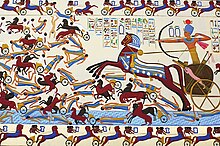Driving (horse)


Driving with horses , ponies , mouth Tierens , or donkeys , called the tightening of equines before a carriage , carriage , carts , carriages , or another wagon using a harness .
history
There is now anthropological evidence that horses were ridden before they were harnessed. The clearest evidence for the domestication of the horse, however, is the Sintaschta - chariot graves in the southern Urals from around 2000 BC. In the following years domesticated horses spread across Europe. For the next 500 years, evidence of driven horses is found in Greece, Egypt, and Mesopotamia. Another 500 years later, horse-drawn carts can be found in China.
Horses may have been harnessed earlier. The standard of Ur , from ancient Sumer , around 2500 BC BC shows four-horse donkey wagons that may have been carrying a yoke .
When the Hyksos in Egypt around 1600 BC When horses broke in BC, horses with breastplate harnesses pulled the chariots, which allowed the horses to move more freely and thus could pull more weight.
The kumt was developed in China ( Southern and Northern Dynasties ) in the 5th century . It allowed heavier tensile loads through better pressure distribution on the shoulders. The Kumt reached Europe in the 9th century and has been used across the board since the 12th century. The marathon harness, which distributes the pressure on the shoulder and chest, ie over an even larger area, was developed in connection with the cross-country ride called the "marathon" of the combined tests after the Second World War. It is lighter than the workload, which also distributes the load very well.
With the advent of the railroad , automobiles , tractors, and other motorized vehicles, horses gradually became obsolete after World War I and, to a large extent, after World War II .
In developed countries, draft horses are mainly used for leisure and sport. In many less developed countries there is still a need for draft horses for transport and agriculture.
education
Like all horses in human care, a driving horse requires basic training. When it is at least two years old, you can start running in. Lungeing and driving off the ground are part of driving training .
Driving style
The Achenbach driving system is taught in Germany. This is a driving instruction in equestrian sport developed by Benno von Achenbach , which has spread throughout Central Europe and has become a quasi-standard in Germany in terms of equipment, aids, leash guidance, teaching and competitions.
Areas of application
Horses can be used as draft animals in agriculture for plowing and other agricultural work. In car-free holiday resorts they pull wagons , in other parts of the world they pull carts , ships , agricultural equipment or, as a gentle means of operation, tree trunks in natural silviculture . Horses are harnessed to celebratory occasions such as weddings, military parades, for example the British Trooping the Color, or in tourism, for example in front of watt wagons.
In trotting races they pull lightweight sulkies for one person. At the other end of the scale, pulling performance competitions with heavy pulling loads are held. The spectrum of tests ranges from skijoring , trotting , traditional driving , the TERC attelé , which is popular in France, to international combined tests .
Tension
There are different ways of tension. In the case of multiple horses, several horses pull together. They can be arranged differently. You can pull with or without logs or toy scales. You can wear a breastplate, marathon or kumt harness. The style can be English, Hungarian, American, or work tension.
Individual evidence
- ^ Chamberlin, J. Edward. Horse: How the Horse Has Shaped Civilizations. Bluebridge, 2006, pages 166-167, ISBN | 0-9742405-9-1
- ↑ Needham, Joseph (1986). Science and Civilization in China: Volume 4, Physics and Physical Technology, Part 2, Mechanical Engineering. Taipei: Caves Books Ltd., pp. 317-322.



